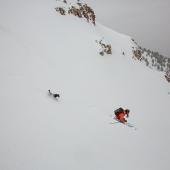High Alert
Considering altitude for canine companions.
Practicing veterinary medicine in Big Sky, at up to 10,000 feet of elevation, I see and treat many cases of pulmonary edema, altitude sickness, and heart disease in horses and dogs. Difficulty breathing is the first and most obvious sign, as pulmonary edema and altitude sickness can include swelling of the lungs or accumulation of fluid that interferes with effective breathing. Struggling for air is uncomfortable, and afflicted dogs can’t catch their breath, even at rest.
Causes
Lack of acclimation accompanied by high-altitude activity may be the cause of your animal’s discomfort. However, distressed, rapid, relentless, or difficult breathing could also be associated with underlying medical conditions such as heart disease, respiratory infection, asthma, or a collapsing trachea. That said, the healthiest dogs and humans can succumb to the vagaries of altitude sickness from time to time. The body likes oxygen, and when oxygenation becomes impaired, breathing troubles can be intense. High temperatures also contribute to breathing distress. Make sure your pup stays cool.
Heart weaknesses and lung conditions contribute to the severity of the condition, as can allergies and infection. Gradual, measured acclimation to altitude is recommended. Subtle conditions not apparent at lower altitudes may present themselves clinically under the duress of altitude and exercise. Aging dogs become more susceptible as time wears on. Just because Luna had an uneventful climb last year doesn’t mean the trip will be a merry one this go-round. Don’t forget your dog’s annual physical before setting off on a high-alpine scouting mission, and make sure your dog stays hydrated during all your outings.
Signs
Milder cases of altitude sickness manifest as coughing at night, often beginning a few hours after activity has subsided. The dog may refuse to sit or lie down, as those postures make breathing more difficult. As the condition worsens, relentless panting fails to diminish with rest. The dog may prefer a sitting position with the elbows held wide and head stretched out, refusing to lie down. Your dog may tire easily and require frequent rests, reluctant to continue. Labored breathing is a telltale sign, which may be caused by airway inflammation or fluid in the airways and lungs. This may be accompanied by coughing and blood-tainted spittle, a worried expression, distressed eyes, and unremitting panting.
In young dogs, excessive panting may be congenital heart disease or anemia from internal parasites. Older or heavy dogs may suffer from congestive heart failure, which is severely worsened with exercise at altitude. Backup of fluid into the lungs from a weak or aging heart is aggravated by even mild activity at high elevations. Intake of untoward amounts of salt can aggravate heart disease and pulmonary edema. Many aging dogs should be on a low-sodium or sodium-free diet. Adequate hydration and maintenance of normal electrolyte levels becomes compensated at high elevations, and medical problems ensue on several levels.
Prevention
Careful conditioning and gradual acclimation are recommended before all high-altitude trips. Proper medical treatment of underlying health conditions can prevent exercise-associated breathing complications. Avoid strenuous exercise—especially at high altitudes—to which your dog is not accustomed, difficult snow (deep, wind-pressed, crusted), and extremes of hot or cold weather.
See your veterinarian for a physical exam and consultation prior to departure. She will discuss proper conditioning and consider the need for administration of preventive and ameliorative medications, which can be critical, as pulmonary edema and altitude sickness can be life-threatening. Retreating to a lower altitude is always recommended and often required for the breathing to return to normal. Avoid salt, and salty treats like bacon, ham, and cheap dog treats, as these cause additional fluid retention and contribute to pulmonary edema. Many dogs coming to altitude manifest symptoms of underlying heart disease that was asymptomatic at sea level. Weak hearts and lungs become even weaker at altitude. It is possible to prevent lung and heart issues with medication prescribed by your veterinarian.
Treatment
Discontinue activity. Transport the dog to a lower altitude in a manner that allows easy breathing. If the gums become pale or purple, mouth-to-nose breathing may be necessary until the gums regain their normal color and refill time. Administer oxygen if available, which it often is at high altitudes. I recommend that you bring oxygen for yourself and your dog if you plan to travel at unaccustomed elevations where there could be problems. Simply allow the oxygen to flow near your dog’s nostrils, rather than into the mouth, in a wind-free environment.
Seek veterinary care if breathing difficulty doesn’t improve with rest or the return to lower elevation. Subsequent or underlying lung disorders or infections and aggravation of pre-existing medical conditions can complicate altitude sickness. See your veterinarian if your dog experiences difficulty breathing or tires easily on high-altitude hikes. Furosemide is a commonly employed pharmaceutical treatment. It is a diuretic, which lowers the arterial blood pressure in the lungs. Side effects include electrolyte imbalances and dehydration. Other preventive medications include triamcinolone. Cortisones that have a fluid retention effect should be avoided (prednisone and the like).
Sid Gustafson is a practicing veterinarian, equine behavior educator, and novelist.














